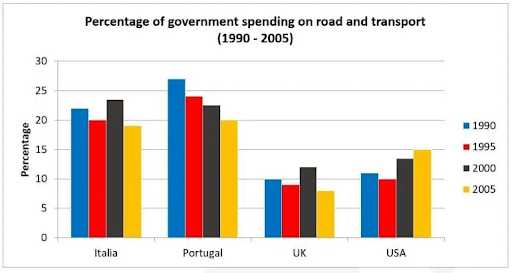Summarize the information by selecting and reporting the main features, and make comparisons where relevant.
Summarise the information by selecting and reporting the main features and make comparisons where relevant.

Bài mẫu
The provided bar chart delineates the changes in government expenditure on roads and transport across several nations from 1990 to 2005.
Throughout this period, there was a consistent downward trend in state investment in roads and transport in Portugal, whereas the United States witnessed an increase. The remaining two nations demonstrated varying patterns in government spending within this sector. Portugal consistently upheld its status of the highest spender among the countries scrutinized.
In mainland Europe, Portugal initially allotted approximately 27% of its national budget to roads and transport in 1990, a substantially larger proportion compared to other nations. However, this percentage experienced a gradual decline, reaching 24% by 1995 and further descending to slightly above 20% by the conclusion of the period. Conversely, the USA exhibited a different trajectory, initially undergoing a minor decrease in the first five years, but ultimately directing a higher proportion of public spending towards road and transport, culminating at 15%.
Italy portrayed a more fluctuating pattern in spending, diminishing from 22% to nearly 20% in 1995, rebounding to 23% in 2000, and then regressing to approximately 19% by 2005. The UK mirrored similar trends, initially allocating slightly over 10% of its total expenditure towards roads and transport, witnessing a minor reduction in 1995, an increase to 12% in 2000, but subsequently decreased spending to about 8% by 2005, maintaining the lowest spending among the listed nations.
[stu alias=”khoa_truy_cap_cac_bai_giai_de”]Từ vựng tốt trong bài
- Consistent downward trend (v): xu hướng giảm liên tục, không đổi
Giải thích: Continuous and unchanging decrease over time.
Ví dụ: The stock prices displayed a consistent downward trend, leading to concerns among investors.
- Consistently uphold (v): luôn duy trì, không thay đổi
Giải thích: maintained continuously and consistently.
Ví dụ: The company consistently upheld high-quality standards in its products, earning the trust of customers.
- Allot (v): có, chia sẻ
Giải thích: to give something, especially a share of something available, for a particular purpose
Ví dụ: They allotted a separate desk to everyone.
- Trajectory (n): quỹ đạo
Giải thích: the curved path that an object follows after it has been thrown or shot into the air
Ví dụ: The missile came in on a very low trajectory.
- Undergo (v): trải qua
Giải thích: to experience something that is unpleasant or something that involves a change
Ví dụ: She underwent an operation on a tumour in her left lung last year.
- Culminate (v): đỉnh điểm
Giải thích: to have as a result or be the final result of a process
Ví dụ: Secret negotiations culminated in the historic peace accord.
- Rebound (v): phục hồi
Giải thích: to rise in price after a fall
Ví dụ: Cotton rebounded from declines early in the day to end at a higher price.
- Regress (v): thoái lui
Giải thích: to return to a previous and less advanced or worse state, condition, or way of behaving
Ví dụ: She suffered brain damage from the car accident and regressed to the mental age of a five-year-old.
Lược dịch tiếng Việt
Biểu đồ cột cung cấp mô tả những thay đổi trong chi tiêu của chính phủ cho đường bộ và giao thông ở một số quốc gia từ năm 1990 đến năm 2005.
Trong suốt thời kỳ này, đầu tư nhà nước vào đường sá và vận tải ở Bồ Đào Nha có xu hướng giảm nhất quán, trong khi Hoa Kỳ chứng kiến sự gia tăng. Hai quốc gia còn lại thể hiện các mô hình chi tiêu chính phủ khác nhau trong lĩnh vực này. Bồ Đào Nha liên tục giữ vững vị thế là quốc gia chi tiêu cao nhất trong số các quốc gia được xem xét kỹ lưỡng.
Ở lục địa châu Âu, Bồ Đào Nha ban đầu phân bổ khoảng 27% ngân sách quốc gia cho đường bộ và giao thông vào năm 1990, một tỷ lệ lớn hơn đáng kể so với các quốc gia khác. Tuy nhiên, tỷ lệ phần trăm này giảm dần, đạt 24% vào năm 1995 và tiếp tục giảm xuống trên 20% một chút vào cuối giai đoạn này. Ngược lại, Hoa Kỳ lại thể hiện một quỹ đạo khác, ban đầu có mức giảm nhẹ trong 5 năm đầu tiên, nhưng cuối cùng lại hướng tỷ lệ chi tiêu công cao hơn vào đường bộ và giao thông, đạt đỉnh điểm là 15%.
Ý thể hiện một mô hình chi tiêu biến động hơn, giảm từ 22% xuống gần 20% vào năm 1995, tăng trở lại 23% vào năm 2000, và sau đó giảm xuống khoảng 19% vào năm 2005. Vương quốc Anh cũng có xu hướng tương tự, ban đầu phân bổ hơn 10% tổng chi tiêu. tổng chi tiêu của nước này cho đường bộ và giao thông giảm nhẹ vào năm 1995, tăng lên 12% vào năm 2000, nhưng sau đó giảm chi tiêu xuống khoảng 8% vào năm 2005, duy trì mức chi tiêu thấp nhất trong số các quốc gia được liệt kê.
[/stu]











